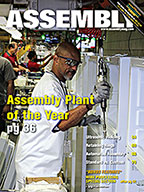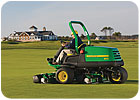
Itron Inc., John Deere Turf Care, Stihl Inc. and Daimler-Western Star operate state-of-the-art plants that assemble utility meters, lawnmowers, chainsaws and heavy-duty trucks. In addition to producing diverse products, each facility follows a unique production philosophy. But, all four plants have something in common: They were finalists in the 2010Assembly Plant of the Yearcompetition sponsored by ASSEMBLY magazine and The Boston Consulting Group Inc. (BCG).
There was a strong field of candidates for the 7th annual award. That made it difficult for the team of judges, which included ASSEMBLY’s editorial staff and BCG’s operations practice, to narrow down the list to five finalists.
All of the assembly plants were worthy of consideration, but at the end of the evaluation process one stood out from the others: the Eaton Corp. plant in Lincoln, IL. The facility was selected asAssembly Plant of the Year because it has remained innovative and cost-efficient, despite the recent meltdown of the housing market.
However, the other finalists are also quite impressive, because they all have improved productivity by harnessing technology and lean manufacturing principles. ASSEMBLY and BCG applaud Itron, Deere, Stihl and Western Star for their efforts. Here’s a brief look at what makes each of these world-class plants stand out.
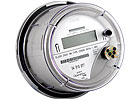
Itron's Waseca, MN, plant assembles circuit boards and electronic modules that are used in OpenWay meters.
Itron Inc.
The smart-meter industry is projected to grow 27 percent annually over the next five years. That dramatic growth will be driven by widespread demand for energy efficiency and resource conservation.There are almost 3 billion utility meters in use around the world, but fewer than 10 percent of them use automated reporting technology. As a result, business is booming at Itron’s assembly plant in Waseca, MN. The 110,000-square-foot facility operates three shifts that build circuit boards and electronic modules that are installed in smart meters used by electric, gas and water utilities to measure and monitor consumption activity.
By aggressively applying lean tools in 2009, assemblers found ways to reduce inventory and cost, resulting in more than $2 million in savings. Last year, Itron shipped its 30 millionth gas unit from the 16-year-old Waseca factory. Earlier this year, an additional assembly line was installed at the plant and 40 new people were hired, due to strong demand for Itron’s OpenWay smart grid platform.
“Our methods of cost control and the quality levels on the products that we produce have allowed us to continue manufacturing in the United States,” says Loren Dietz, focus factory manager. Itron Waseca has been pursuing lean manufacturing initiatives for more than five years with positive results.
“We have driven inventory down to very low levels through kanban, just in time and vendor-managed inventory,” Dietz points out. “We have moved from build-to-stock to build-to-order on all product lines. 5S has become part of the culture and helped us to reclaim roughly 20 percent of our production floor space.
“We are closely coupled with our engineering organization so that we can have real-time manufacturing and design input into new designs, and provide them with a prototype service for designs still in development,” adds Dietz. “The common processes that we utilize give us true flexibility to build multiple product lines through our manufacturing production lines.”
Itron’s product support teams focus on quality. They have implemented a real-time statistical process control system to track defect rates and cycle times. As a result of its various lean initiatives, the Waseca plant has slashed customer lead time from 90 days to three weeks.
“We have automated several process steps to reduce cycle time and improve process consistency, and are currently working on incorporating automation intelligence and poka-yoke to automation cells,” says Dietz. “In addition, we have implemented common processes and equipment across product lines that allow for common spare parts and common process support.”

The John Deere Turf Care plant in Fuquay-Varina, NC, assembles professional mowing equipment.
John Deere Turf Care
Golf courses are famous for their immaculate fairways, putting greens and sand traps. To maintain that look, country clubs and park districts around the world rely on mowers, aerators, bunker rakes, sprayers and other equipment from John Deere Turf Care. The company operates a 270,000-square-foot assembly plant in Fuquay-Varina, NC.Last year was challenging for the professional mowing and turf maintenance industry, which experienced a 45 percent drop in activity due to the economy. However, through drastically reduced work schedules, the leadership team at John Deere Turf Care limited shut-down periods. For instance, they provided in-house job opportunities for tasks that were normally performed by outside contractors, such as lawn care, maintenance, painting and housekeeping.
“Any and all opportunities were discussed or implemented in an effort to keep our employees working,” says Jason Haritos, manager of environment, safety and health.
Despite those challenges, the John Deere Turf Care plant posted some impressive results. For instance, first-pass quality yield improved from 83 percent in 2008 to 90 percent in 2009. Haritos credits much of the plant’s success to lean manufacturing tools, such as 5S, and a plantwide investment in new assembly technology.
Assemblers rely on state-of-the-art production tools, such as an automated pick-to-light system, which comes in handy, because the plant experiences significant seasonal demand shifts.
“There are seven peak-to-valley production rates throughout the year,” explains Haritos. “During seasons where the factory scales back the total workforce, a significant savings is realized.”
The facility uses paperless work instructions to document 6,000 part numbers across nine product lines with production rates that range from two units per shift to 140 units per shift.
Other productivity-enhancing tools used by John Deere Turf Care include radio frequency identification (RFID), vision systems and DC electric tools to error-proof the assembly process.
Each workstation on the zero-turn radius (ZTR) mower line is equipped with RFID readers that communicate back and forth with the plant’s manufacturing execution system. The reader identifies the unit within the station and ensures that the right parts are installed and that all assembly specifications have been met.
More than 100 assembly line cameras are used in the factory to monitor quality and verify the correct installation of critical components. “Each camera verifies an average of two to three features per machine, or 141features per machine per day,” Haritos points out. “They detect the presence and orientation of parts installed on a unit and can detect the presence, orientation and text on decals.” In 2008, a total of 3,167,283 vision system verifications were completed on the ZTR assembly line.
John Deere Turf Care has also installed smart torque tools on its assembly lines to monitor quality and ensure conformance to specifications. The DC electric and transducerized pulse tools replaced standard impact tools and torque wrenches.
“The ZTR line has a total of 44 data-gathering tools,” says Haritos. “Each tool verifies two to four pieces of hardware, or 133 pieces of hardware per machine.” Last year, 2,987,579 pieces of hardware had installation torque verified on the ZTR assembly line.
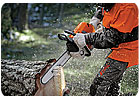
A wide variety of chainsaws are produced at Stihl Inc.'s Virginia Beach, VA, plant.
Stihl Inc.
When it comes to handheld, gasoline-powered chainsaws, Stihl is No. 1. The German company pioneered the technology more than 90 years ago. In 1977, it built a state-of-the-art assembly plant in Virginia Beach, VA, that produces a wide variety of outdoor power equipment.The 1.3-million-square-foot facility is engaged in high-mix, high-volume production. It has seven chainsaw assembly lines that produce 99 different models and 12 power tool assembly lines that produce 213 models, such as trimmers, leaf blowers, edgers and hedge trimmers.
Many different sizes of engines, such as 1.7-hp and 8.5-hp, are built in-house. Key metal and plastic components, such as crankshafts, pistons, housings, guide bars and chains, are also made by Stihl.
The Virginia Beach plant has achieved $30 million in savings over the last three years due to lean manufacturing initiatives and investments in new production technology. Engineers and assemblers have worked together to remove cost from operations. Idea Plus is one of the employee-driven continuous improvement initiatives that has been created.
“As part of the continuous improvement initiative, Stihl encourages all employees to identify and remove waste in any form, identify the root cause of problems, and develop and propose specific solutions,” says Lorraine Wagner, director of manufacturing.
By using line balancing and state-of-the-art assembly equipment, Stihl has increased throughput on its assembly lines. The company has invested $152 million in the Virginia Beach facility in the past three years. Much of that investment has been in automation, especially for producing complex subassemblies.
Since 2007, Stihl engineers have installed 34 new robots on the plant floor. Last year, the number of robots per 2,000 employees at the facility was 74.
“This level of automation is world class,” claims Wagner. “[Our facility] now exceeds even Japan for the number of robots per 2,000 employees, as determined by the International Federation of Robotics.”
The plant also uses cutting-edge test and inspection technology. It boasts more than 135 test cells that are located next to assembly lines for easy access. Every product that comes off the line is rigorously tested before being packaged and shipped to dealers to ensure Stihl’s reputation for quality.
One of the plant’s main projects last year was to reduce average test cell cycle time by approximately 100 seconds. “A pilot assembly line was chosen and the successful project drove a cost reduction of $210,000 on that line alone and allowed three of 14 test cells to be removed,” says Wagner. The innovation will now be applied to other assembly lines at the plant, saving Stihl approximately $1 million per line.
Overhead electronic boards have been installed on each assembly line in the plant to visually disseminate production information, such as quality, number of units produced and takt time. The information is constantly updated to provide accurate real-time data that can be reviewed from any location that has Web access-not just locations in the facility. Additionally, historical data can be exported in a number of different formats for analysis.
Touch screen computers have also been installed on the assembly lines to augment traditional paper work instructions. The system gives employees direct access to bills of materials, drawings, tools, contact lists and real-time quality information.
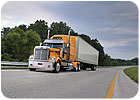
Daimler Trucks North America builds Western Star vehicles in Portland, OR.
Western Star
Daimler Trucks North America LLC operates several divisions that produce leading brands of heavy-duty vehicles, such as Freightliner, Thomas Built Bus and Western Star. Assemblers build Western Star vehicles for long-haul and vocational applications at the 41-year-old Portland Truck Manufacturing Plant (PTMP).The 474,387-square-foot facility has improved its performance over the past three years, despite facing several challenges. For instance, economic conditions forced management to continually shift product mix and rate. In 2007, 8,613 vehicles were assembled vs. 6,065 vehicles in 2008 and 3,757 in 2009.
The plant continued to implement lean manufacturing principles while facing periodic shutdowns and painful workforce reductions. “The efforts paid off with improvement in all relevant production measurement categories, such as safety, quality, delivery and cost,” says Terry McCullough, continuous improvement coordinator.
Because of lean initiatives, total operating cost dropped from $144 million in 2006 to $75 million in 2008. During the same time period, scrap rate per vehicle was slashed from $74 in 2006 to $23 in 2008. Instead of closing the Portland plant, Daimler Trucks North America decided to keep the facility open.
And, last year, the plant ranked No. 1 in the company for its “quality focus and robust processes” and “just-in-time” disciplines. “We also received 2nd place awards for ‘human infrastructure’ and ‘continuous improvement,’” says McCullough.
Part of that success is due to self-directed work teams. “A 12-to-1 ratio between team members and team leaders enables necessary problem-solving techniques at the source and allows team accountability rather than assigning blame,” McCullough points out.
Routine quality checks and defined feedback loops have allowed quality issues to be corrected at the point of error. As a result, dramatic increases in first-time quality have been realized.
An employee suggestion system resulted in an average of 5.2 ideas per employee in 2009. “Employee suggestions for product and process improvements allowed for a savings of $41.48 per vehicle,” claims McCullough.
Last year, the Western Star plant initiated a program designed around the Toyota 8 Step Problem Solving Method, with shop floor and management employees focused on improving customer quality to both internal and external customers. Major and repeated defects are subject to mandatory problem solving.
“Technology has [also] enabled our facility to take advantage of many previously missed opportunities,” says McCullough. “[For instance], RFID allows logistics to be tracked throughout our plant. Inventory levels, warehouse storage and line-side usage points are now monitored, tracked and analyzed electronically. Fluctuations in inventory levels will visually trigger materials replenishment. Web Focus reports also provide forecasting in materials and allow for vehicle scheduling.”
Torque tools, pneumatic impact wrenches, battery-powered tools and wireless test equipment are used throughout the plant to improve productivity and address ergonomic issues. In addition, robots now perform more than 90 percent of the welds in the cab manufacturing process. “This has increased overall product throughput and allowed for several model and mix changes in the recent months,” says McCullough.



